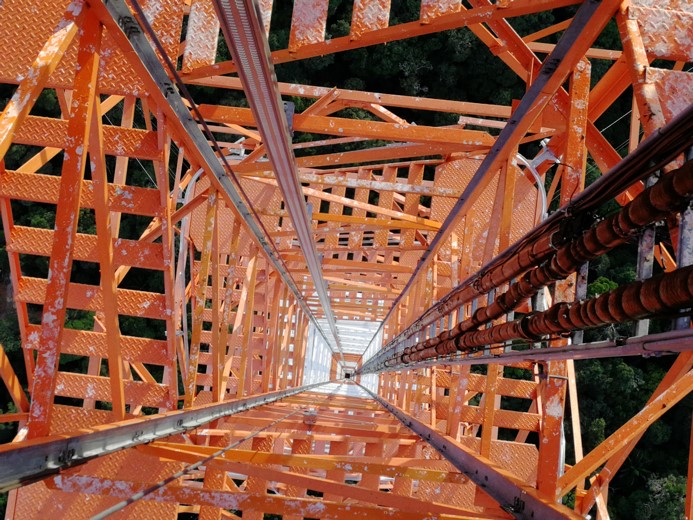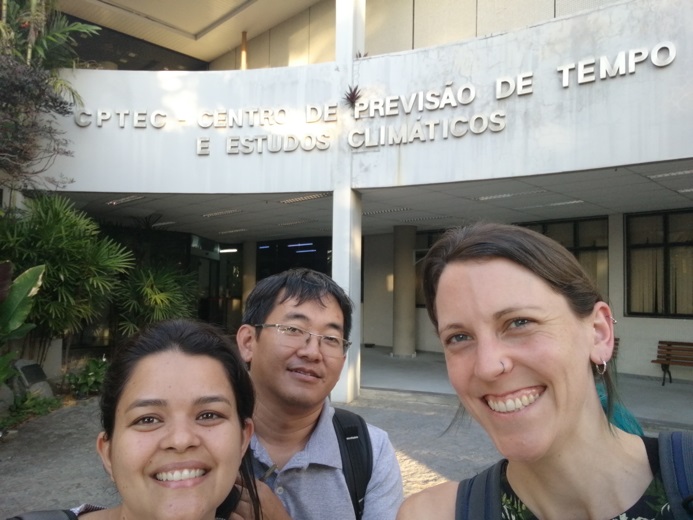A UK-Brazil exchange
Blog post - Partners in science – a UK-Brazil exchange
Over three hundred metres above the forest floor and the towering canopy of the Brazilian rainforest is reduced to a rolling green carpet far beneath my feet. Clouds sweep across the sky, casting shifting shadows over matchstick trees that stretch to the horizon. I’m standing at the top of the Amazon Tall Tower Observatory (ATTO), which is a metre taller than the Eiffel Tower and arguably has a more spectacular view.

The staggering steel structure is located 150 km northeast of Manaus as the crow flies, though with a journey along winding roads, river and dusty tracks, travelling here is not without its challenges. The remoteness of the location is important, as the tower was built to monitor complex interactions between the forest and the atmosphere, away from the contaminating pollution of the city. Instruments situated at different heights above the ground monitor the exchange of water, energy, aerosols and greenhouse gases. They also record weather data, helping to give us a better understanding of how the intact Amazon forest responds to, and influences, the climate.
I visited the ATTO site in February 2019, while participating in the BrasilFlux workshop hosted by the National Institute of Amazonian Research (INPA), one of the Brazilian partners in the Climate Science for Service Partnership Brazil (CSSP Brazil) project. The workshop provided a great opportunity to meet Brazilian researchers involved in running the Brazil flux tower network, and learn about the challenges involved in data collection and processing. Flux tower measurements provide a vital ‘ground truth’ for those, such as myself, who work with satellite observations or output from climate models. Given the substantial time and expense required to collect the data, strong links between data producers and data users are essential for establishing productive research partnerships.

My visit to Brazil was part of an exchange to promote scientific collaborations between the UK and Brazil, supported by the CSSP Brazil project. Following my adventure in the remote heart of the Amazon, I travelled to Cachoeira Paulista, a small and generally sleepy town in the otherwise bustling state of São Paulo. Here, I spent three weeks working at CPTEC, the Brazilian weather prediction agency. CPTEC is set in an expanse of verdant grounds, with eucalyptus-lined paths and a panoramic view of the distant mountains, sometimes obscured by rolling storm clouds. The aim of the visit was to evaluate the UK and Brazil climate models using a new suite of analysis tools developed by the University of Leeds. Working closely alongside my Brazilian hosts enabled us to share expertise, develop research ideas together, and build a strong foundation for future collaborations.
Following my time at CPTEC, I travelled back to the UK with Dayana Castilho, a postdoctoral researcher at CPTEC, to continue our work on the other side of the Atlantic. Dayana spent two weeks in the UK, visiting the University of Leeds and the Met Office, where she presented her work and met some of the UK partners of the CSSP Brazil project. Outside of work, we enjoyed time experiencing one another’s cultures, sampling new foods, and taking it in turns to lose to each other at bowling!
As I continue my research, sitting at my desk on another grey Leeds day, I am often transported back to my time in Brazil: the raucous orchestra of rainforest insects, feeling on top of the world at the top of ATTO, or running to the cool interior of CPTEC to escape from a sudden tropical downpour. I am so grateful to my Brazilian colleagues and friends for welcoming me to their beautiful country, and look forward to continue working together on exciting scientific research.
Jess Baker
Researcher, University of Leeds
2019





